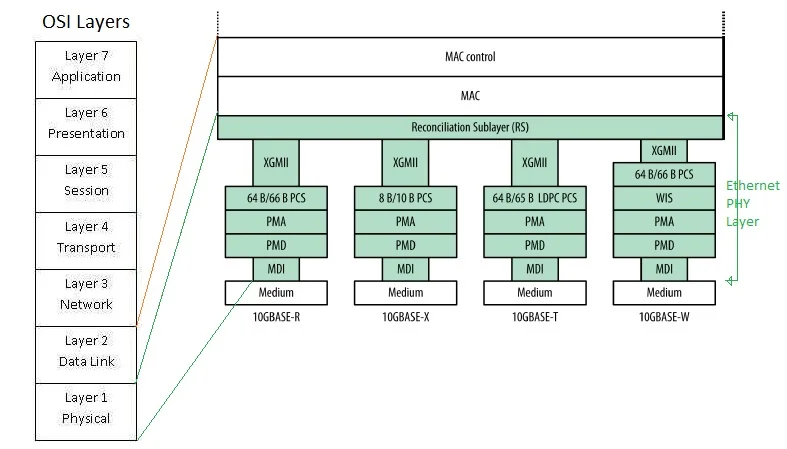10 Gigabit Ethernet Physical Layer | 10g ethernet phy
There are various physical layers in 10 Gigabit Ethernet based on medium the data has to be transported such as copper, fiber optic etc. The physical layer sub groups are 10GBASE-R(developed for optical fiber medium), 10GBASE-X (developed for copper and optical fiber) , 10GBASE-T (developed for twisted pair cable) and 10GBASE-W(developed for OC-192 SONET). In this article we will take example of 10GBASE-R to understand the 10g ethernet PHY layer.
As shown in the figure, 10g ethernet consists of sublayers which include XGMII (10 Gbps Media Independent Interface), PCS (Physical Coding Sublayer), PMA(Physical Medium Attachment), PMD (Physical Medium Dependent) and MDI(Medium Dependent Interface). We will understand functions of these sublayers used in 10GBASE-R.

Following are the functions of 10 Gigabit ethernet PHYSICAL Layer:
• It should support full duplex ethernet MAC layer.
• It provides 10 Gbps at the XGMII sublayer.
• It should support LAN PMD sublayer at 10 Gbps.
• It should support WAN PMD sublayer which operates at SONET/SDH rates.
• It should support network extension upto the distance of 40 Km.
• It should support copper as well as twinaxial cable as medium.
• Bit Error Rate(BER) of 10-12 should be achievable.
10g ethernet phy | Reconcillation XGMII PCS PMA PMD
Let us understand 10GBASE-R ethernet physical layer type, It will have transmitter as well as receiver functionalities. We will understand all the sublayers of this ethernet physical layer.
Reconciliation Sublayer:
This sublayer provides a mapping between the signals available at XGMII sublayer and MAC layer.
The RS adapts bit serial protocols of MAC layer to parallel encodings of 10 Gbps PHY sublayers.
Basically RS sublayer converts between MAC serial data stream and parallel data paths of XGMII. The RS sublayer generates continuous data/control characters for transmit direction. It also expects continuous data/control characters in the receive direction.
XGMII:
This sublayer supports 10 Gbps operation through
its 32 bit wide transmit and receive data paths.
The XGMII sublayer has following features.
• Data and delimiters are synchronous to clock reference.
• It provides independent 32 bit wide transmit as well as receive data paths.
• It supports full duplex operation.
• It supports signal levels as ASIC compliant.
Physical Coding Sublayer(PCS):
The 10GBASE-R PCS will serve XGMII sublayer and does following functionalities:
• Encoding of 8 XGMII data bytes(i.e. 64 bits) to 66 bit blocks
• Decoding of 8 XGMII data bytes from 66 bit blocks
• Transfer of encoded data (16 bit transfer mode) in the transmit direction from XGMII to PMA sublayer.
• Transfer of encoded data from PMA to XGMII in the receive direction.
Refer 64B/66B signal encoding for more.
Physical Medium Attachment(PMA):
This PMA sublayer provides a medium independent means for PCS sublayer to support the use of a range of physical
media. The PMA sublayer in the physical layer type 10GBASE-R performs following functions:
• Mapping of transmit and receive data streams between the PCS or WIS and PMA via the PMA
service interface.
• Serialization (deserialization) of bits for transmission (reception) on the underlying serial PMD.
• Recovery of clock from the received data stream.
• Mapping of transmit and receive bits between the PMA and PMD via the PMD service interface.
• Optionally provides data loopback at the PMA service interface.

The ordering of bits and octets for the case when no WIS(WAN Interface Sublayer) is present between the PCS and PMA for the case of 10GBASE-R Physical layer.
Physical Medium Dependent(PMD):
There are several PMDs designed and developed to meet several medium and distance
requirements.
Following table-1 mention maximum distance supported by various fibre optic cables.
| Fibre type | 62.5 µm MMF(Multi mode fibre) | 50 µm MMF | SMF(Single mode fibre) | ||||
|---|---|---|---|---|---|---|---|
| Nominal wavelength (nm) | 850 | 1300 WWDM(Wide Wavelength Division Multiplexing) | 850 | 1300 WWDM | 1310 | 1550 | 1300 WWDM |
| 10GBASE-S | 33m | 300m | |||||
| 10GBASE-L | 10Km | ||||||
| 10GBASE-E | 40Km | ||||||
| 10GBASE-LX4 | 300m | 300m | 10Km | ||||
| 10GBASE-LRM | 220 m | 220 m | |||||
Following table-2 mention various copper cable types and maximum distances supported.
| Cable Type | Max. distance |
|---|---|
| Twinax | 15m |
| Class E/Category 6 | 55m to 100m |
| Class E/Category 6; unscreened | 55m |
| Class E/Category 6; screened | 100m |
| Class EA/Augmented Category 6 | 100 m |
| Class F | 100 m |
Medium Dependent Interface(MDI):
This sublayer is the cable connector between the signal transceivers and the link.
Medium:
The medium is the physical medium carrying the data either fiber or copper.
In the receiver all the reverse operations will take place to the one outlined in the transmitter part. Refer basics of OSI and TCPIP layers to understand the concept of physical layer, data link layer and upper layers.
